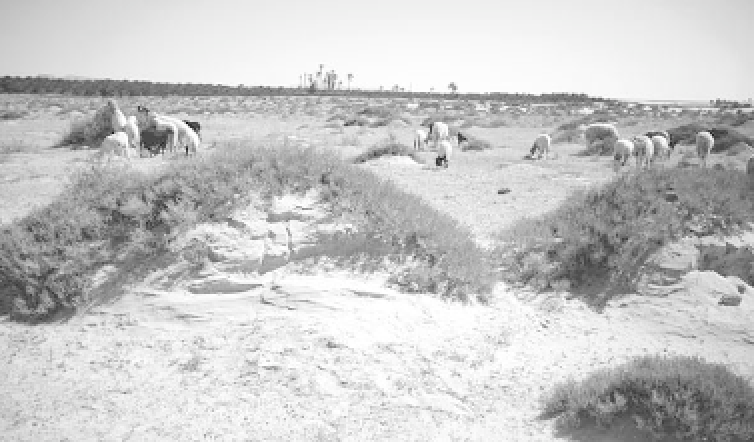Geology Reference
In-Depth Information
Plate 12.9
Nebkha dunes formed from gypsum-rich sands in central Tunisia. Note that the palm trees in the background
are growing on an artesian spring mound.
(
Photograph by Dave Thomas
)
an area of 192,000 km
2
and average thickness of 26 m,
houses 4,992 km
3
of sand. The Namib Sand Sea is more
modest, storing 680 km
3
of sand (Lancaster 1999). Sand
seas that have accumulated in subsiding basins may be
at least 1,000 m thick, but others, such as the ergs of
linear dunes in the Simpson and Great Sandy Deserts of
Australia, are as thick as the individual dunes that lie on
the alluvial plains.
Dunefields and sand seas occur largely in regions lying
downwind of plentiful sources of dry, loose sand, such
as dry river beds and deltas, floodplains, glacial outwash
plains, dry lakes, and beaches. Almost all major ergs are
located downwind from abandoned river courses in dry
areas lacking vegetation that are prone to persistent wind
erosion. Most of the Sahara sand supply, for instance,
probably comes from alluvial, fluvial, and lacustrine sys-
tems fed by sediments originating from the Central
African uplands, which are built of Neogene beds. The
sediments come directly from deflation of alluvial sed-
iments and, in the cases of the Namib, Gran Desierto,
Sinai, Atacama, and Arabian sand seas, indirectly from
coastal sediments. Conventional wisdom holds that sand
from these voluminous sources moves downwind and
piles up as very large dunes in places where its transport
is curtailed by topographic barriers that disrupt airflow
kum
and
peski
in Central Asia, and
nafud
or
nefud
in
Arabia. They are regional accumulations of windblown
sand with complex ancestry that are typically dominated
by very large dunes (at least 500 m long or wide or
both) of compound or complex form with transverse or
pyramidal shapes (Figure 12.8). They also include accu-
mulations of playa and lake deposits between the dunes
and areas of fluvial, lake, and marine sediments. Sand seas
are confined to areas where annual rainfall is less than
150 mm within two latitudinal belts, one 20
◦
-40
◦
N
and the other 20
◦
-40
◦
S. The largest sand sea is the Rub'
al Khali (the 'Empty Quarter') in Saudi Arabia, which is
part of a 770,000-km
2
area of continuous dunes. About
fifty comparable, if somewhat less extensive, sand seas
occur in North and southern Africa, Central and West-
ern Asia, and central Australia. In South America, the
Andes constrain the size of sand seas, but they occur in
coastal Peru and north-western Argentina and contain
very large dunes. In North America, the only active sand
sea is in the Gran Desierto of northern Sonora, north-
ern Mexico, which extends northwards into the Yuma
Desert of Arizona and the Algodones Dunes of south-
eastern California. The Nebraska Sand Hills are a sand
sea that has been fixed by vegetation. A single sand sea
may store vast quantities of sand. The Erg Oriental, with

